Allowed Race List And Info
Halloween Weyr :: Welcome :: Important Things :: Pages Forums :: Star Trek Pages
Page 1 of 1
 Allowed Race List And Info
Allowed Race List And Info
List And Info:
Andorians:
 - Male Andorian
- Male Andorian
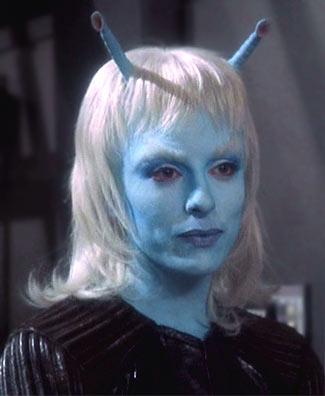 - Female Andorian
- Female Andorian
Andorians are a humanoid species with blue skin and antennae. They consider themselves a warrior race, in contrast with the pacifist Aenar who also live on the Andoria. They are native to the moon Andoria, which orbits the planet Andor. They were a founding member of the United Federation of Planets.
Bajorans:
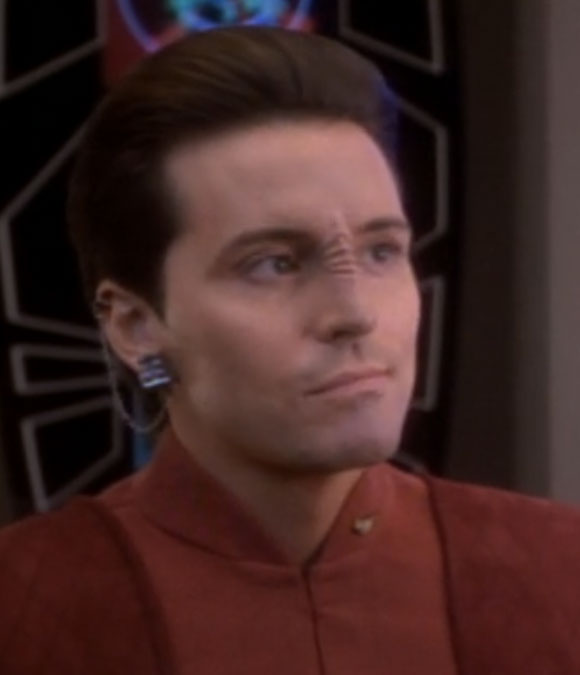 - Male Bajoran
- Male Bajoran
 - Female Bajoran - Kira Nerys
- Female Bajoran - Kira Nerys
The Bajorans are a humanoid species with characteristic nose creases. They live on the planet Bajor. They are a deeply spiritual people, who worship The Prophets. They are enemies of the Cardassians, who occupied Bajor and treated the Bajorans as slaves in the early 24th century.
Benzite's

Benzites are a humanoid race from the planet Benzar and members of the United Federation of Planets. Benzites possess smooth, hairless skin; it may range in color from bluish-purple to green-blue. A thick protrusion of the Benzite skull extends down over the face, displaying a prominent nasal lobe and brow. Two fish-like barbels droop down from above the upper lip. Benzites are highly resistant to poisons and other noxious substances. They can digest and derive nutrition from almost any organic compound. All Benzites from the same geostructure are physically similar, so much so that they are indistinguishable to a non-Benzite.
Betazoids:
 - Male Betazoid
- Male Betazoid
.jpg/revision/latest?cb=20120409065643&path-prefix=en) - Female Betazoid - Deanna Troi
- Female Betazoid - Deanna Troi
The Betazoid are a humanoid species, originating from the planet Betazed. They are telepathic and are members of the United Federation of Planets.
Cardassians (Only Accepted On A Case-To-Case Basis):
 - Male Cardassian Garak
- Male Cardassian Garak
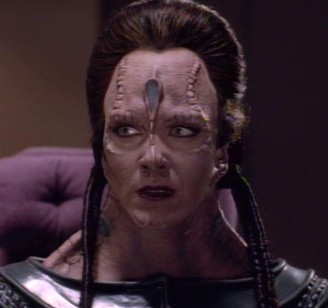 - Female Cardassian
- Female Cardassian
The Cardassians were a humanoid species from the Alpha Quadrant. They were native to the planet Cardassia Prime, capital world of the Cardassian Union. Known throughout the Alpha Quadrant for their ruthlessness, the Cardassians became one of the greatest enemies of the United Federation of Planets and Klingon Empire when they joined the Dominion in 2373. Their xenophobic attitude towards other species was well established throughout the quadrant after the Setlik III massacre during the Cardassian War, as well as when their atrocities during the Occupation of Bajor were revealed after their withdrawal in 2369.
Changeling/Founder/Dominion (Only Accepted On A Case-To-Case Basis):
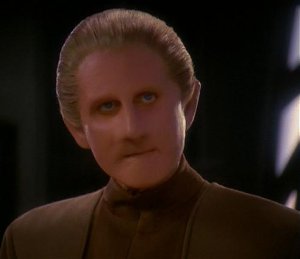 - Male Changeling/Founder/Dominion - Odo
- Male Changeling/Founder/Dominion - Odo
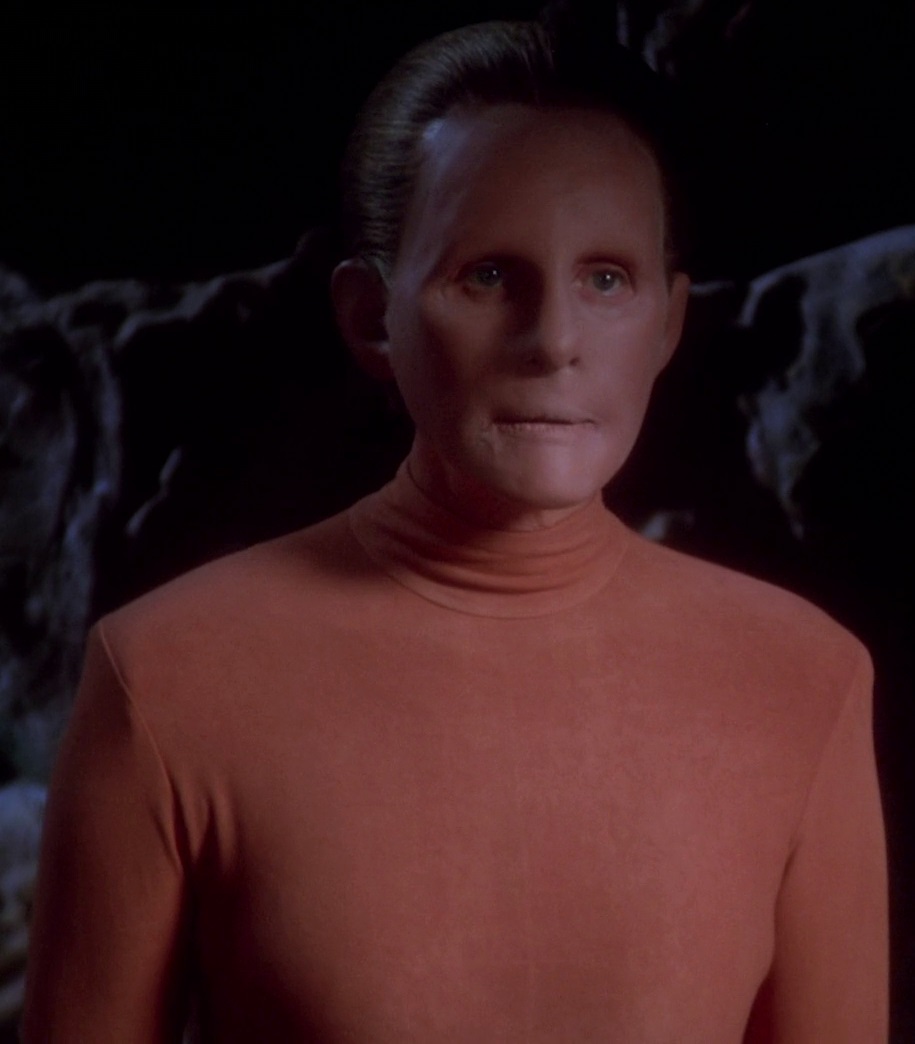 - Female Changeling/Founder/Dominion
- Female Changeling/Founder/Dominion
Changelings were at least partially composed of morphogenic enzymes, the molecules responsible for their shapeshifting ability. (DS9: "Things Past"). Common characteristics of Changelings included their biomolecular structure and morphogenic matrix. In its natural state, a Changeling's body was a formless gelatinous mass, to which it had to revert every eighteen hours (Odo's example) in order to regenerate. (DS9: "The Forsaken", "The Storyteller", "The Alternate", "In Purgatory's Shadow"). If a Changeling remained in solid form for longer than sixteen hours, their body began to deteriorate and peel or "flake' away.
El-Aurian:
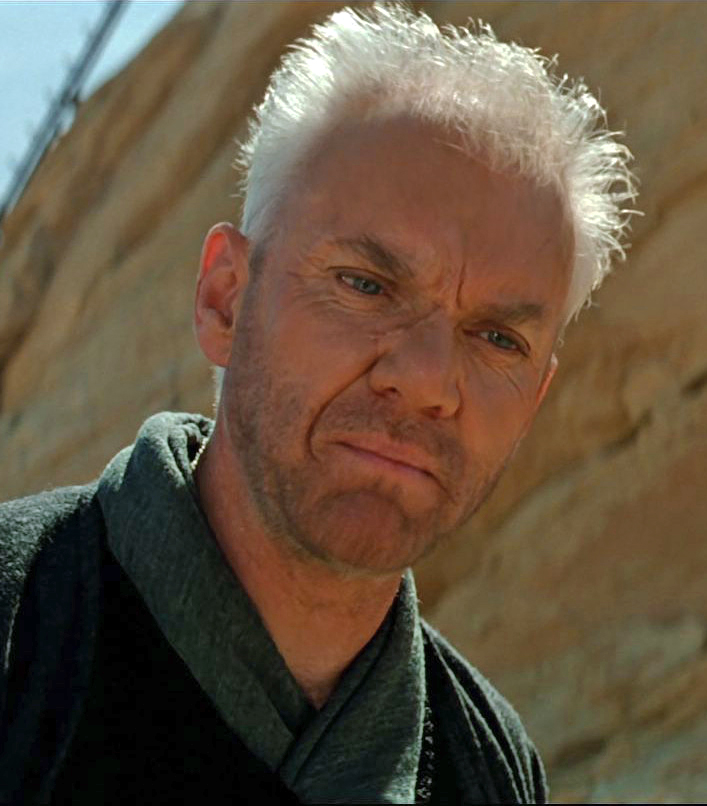 - Male El-Aurian - Dr. Tolian Soran
- Male El-Aurian - Dr. Tolian Soran
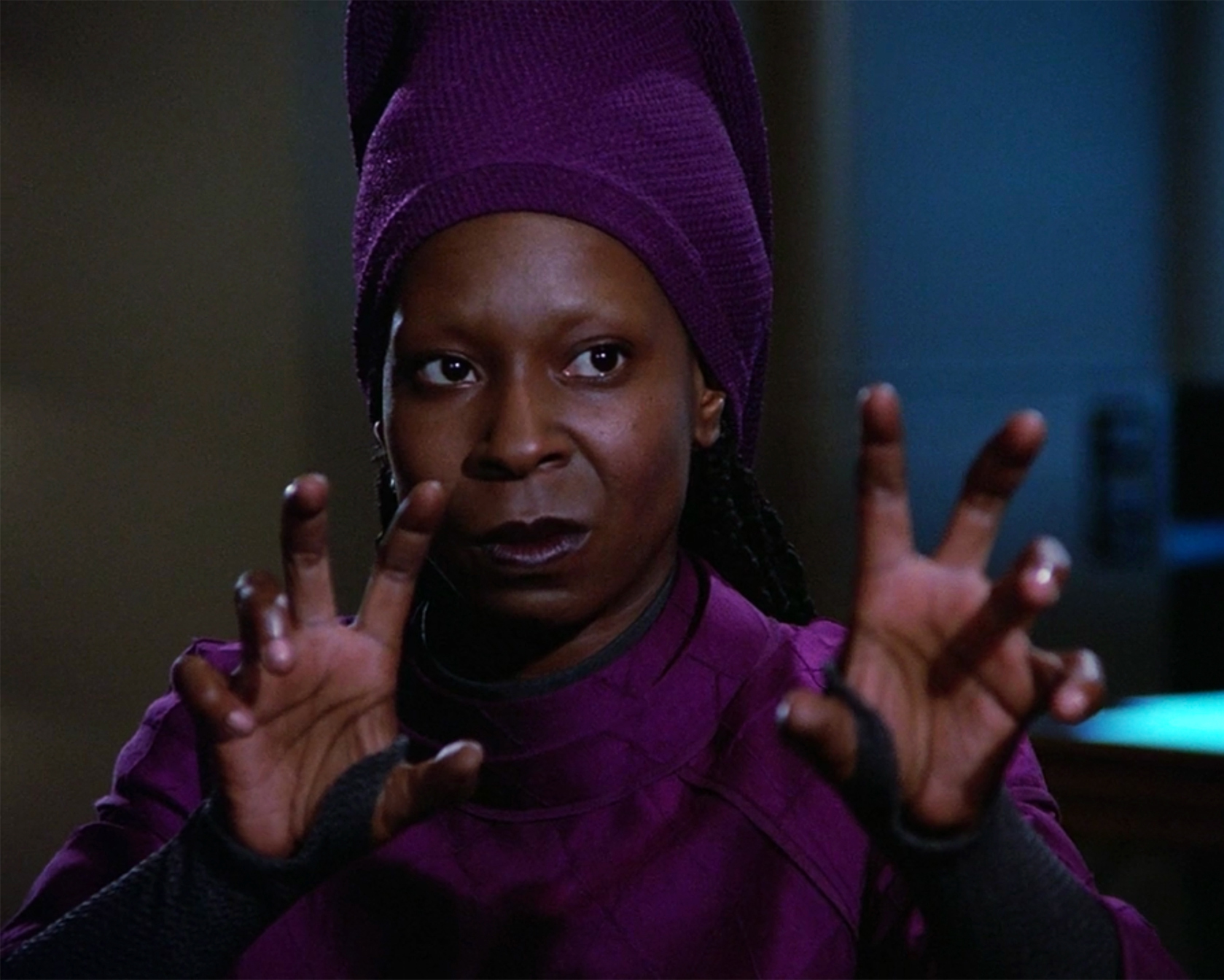 - Female El-Aurian - Guinan
- Female El-Aurian - Guinan
El-Aurians (referred to as a Race of Listeners by Dr. Tolian Soran, the El-Aurian antagonist in Star Trek Generations) are a humanoid race first introduced in the second season of Star Trek: The Next Generation with the character of Guinan. The species was named in the Star Trek: Deep Space Nine episode "Rivals".
El-Aurians are physically similar to humans, but they can live well over 700 years and have a variety of ethnic types, with both dark- and light-skinned members of the race being shown on various Star Trek movies and television episodes. They are considered a race of listeners and often appear patient and wise.
The El-Aurian homeworld was located in the Delta Quadrant and was destroyed by the Borg in the mid-23rd century. Few survived, and those who did were scattered throughout the galaxy. Some of the refugees came to the United Federation of Planets and it has been noted that this is likely an analogy for the spread of Africans around the Earth via colonialism and slavery.
Ferengi (Only Accepted On A Case-To-Case Basis As Candidates, Weyrlings, & Dragonriders; must have a stellar application to be a Candidate; think like a Queen Rider/Candidate on a Canon Weyr):
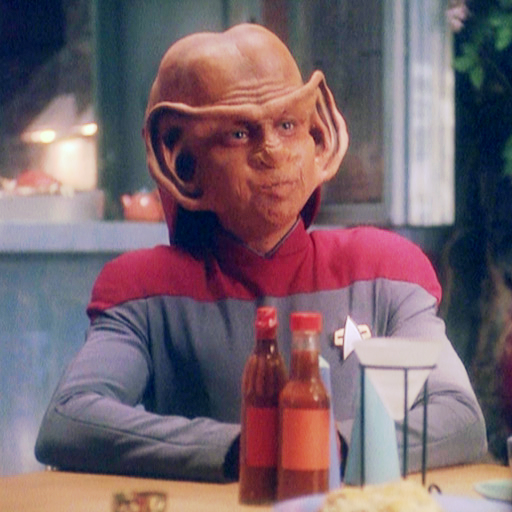 - Male Ferengi - Nog
- Male Ferengi - Nog
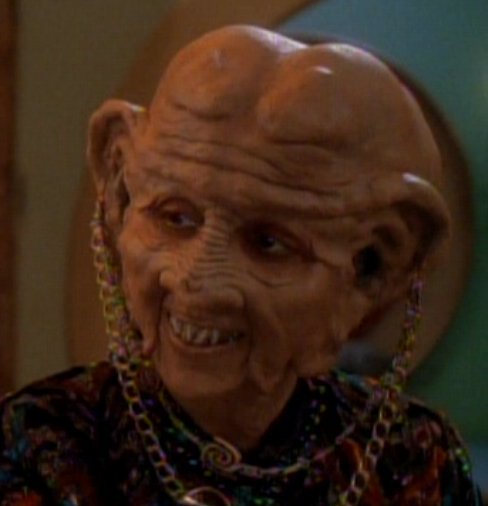 - Female Ferengi
- Female Ferengi
The Ferengi were a warp capable humanoid species from the Alpha Quadrant. They originated from planet Ferenginar. Ferengi civilization was built on a caricature of free enterprise, where earning profit was the sole meaningful goal in life, superseding all other endeavors.
The Ferengi governing body, known as the Ferengi Alliance, was formed over a period of ten thousand years, beginning with the establishment of a system of currency, to their purchase of warp technology, and finally to its state in the 24th century. (DS9: "Little Green Men")
Humans (Earth familiar ones):
 - Male Human - Captain Jean-Luc Picard
- Male Human - Captain Jean-Luc Picard
 - Female Human - Lieutenant Tasha (Natasha) Yar - Deceased
- Female Human - Lieutenant Tasha (Natasha) Yar - Deceased
Humans (Homo sapiens), also known as Terrans, were a warp capable humanoid species from the Alpha Quadrant. The species originated from the planet Earth in the Sol system. Humans were the only surviving race of several sentient/intelligent species to have evolved from the Genus Homo. Humans were also one of two known spacefaring intelligent species to have originated from Earth; the other being the Voth, who had come to live in the Delta Quadrant by the 24th century.
As the Latin word for their homeworld was "Terra", Humans were sometimes referred to as "Terrans", but not always. (This usage was consistent in the mirror universe.) Occasionally the term Terran was used to distinguish Humans living on Earth from those resident on colonies on other planets and moons. Some people used the adjective "Terran" to refer to subjects or institutions associated with Humanity (Terran cuisine, Terran literature, Terran art, etc.). The Borg designation for Humans was Species 5618. (VOY: "Dark Frontier")
A founding member of the United Federation of Planets, Humans of Earth became warp capable in 2063, which was the same year they experienced first official contact with an alien species, the Vulcans. The first warp-drive was engaged on April 5th of that year by Zefram Cochrane. (Star Trek: First Contact; ENT: "Broken Bow", "Desert Crossing", "E²"; VOY: "Year of Hell", "Relativity", "Homestead"). These are the ones that the original settlers on Pern Originated from and the current main Species on Earth.
Klingons:
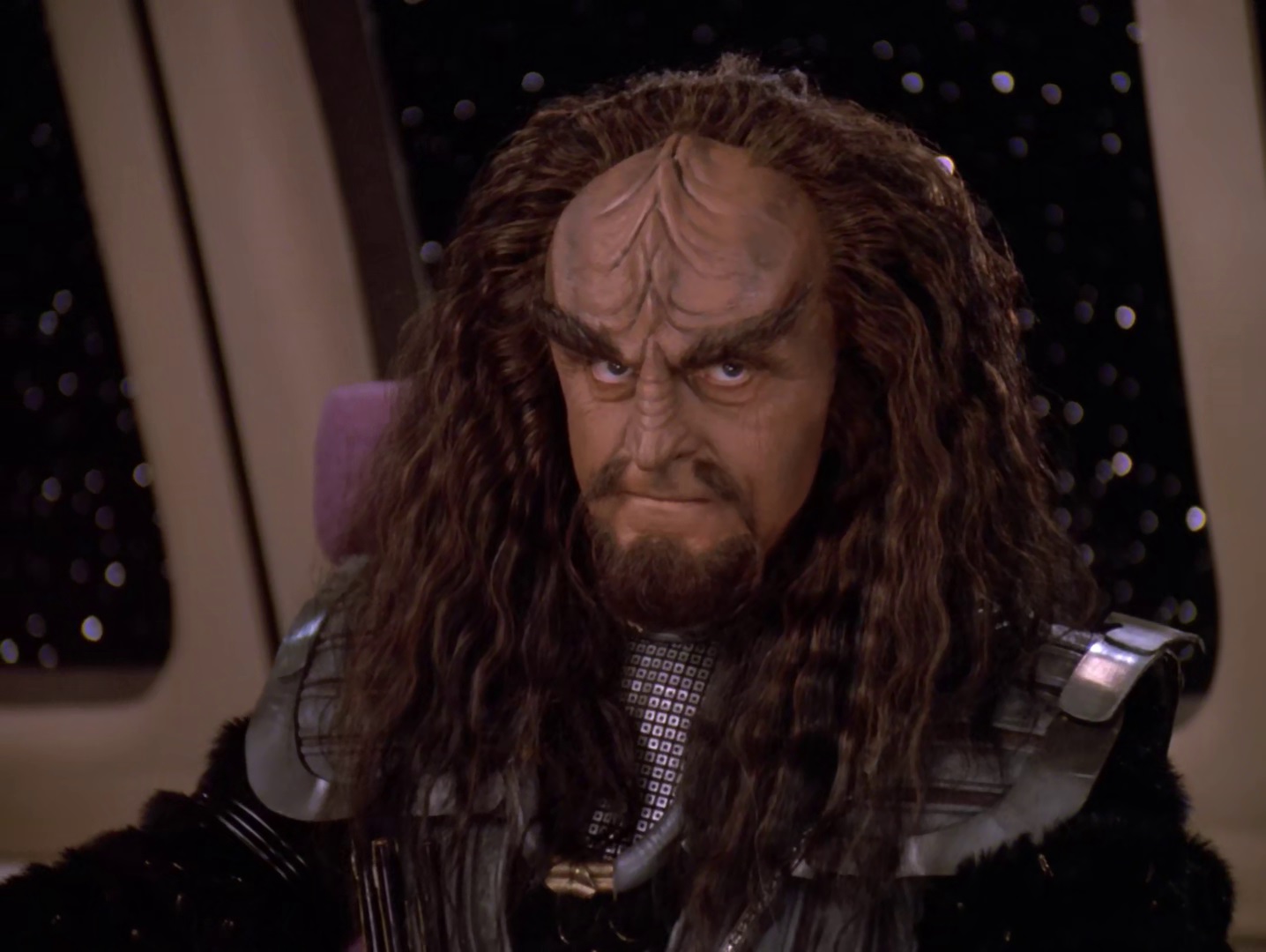 - Male Klingon - K'mtar
- Male Klingon - K'mtar
 - Female Klingon
- Female Klingon
The Klingons were a humanoid warrior species that originated from the planet Qo'noS (pronounced Kronos), an M-class planet. One of the major powers of the galaxy, the Klingons were a proud, tradition-bound people who valued honor and combat. The aggressive Klingon culture had made them an interstellar military power to be respected and feared.
The Klingon Empire was founded some time in the 9th century by Kahless the Unforgettable, who performed many heroic feats including the unification of the Klingon people when he killed the tyrant Molor. Kahless came to be revered in Klingon society to the point of near-deification, and many aspects of Klingon culture came to revolve around an emulation of Kahless' life. (TNG: "Rightful Heir")
The warrior ethos had been an important aspect of Klingon society since the time of Kahless, but the warrior aspects became much more dominant beginning in the early 22nd century. Previously, Klingon society was regarded as socially balanced, but over time, the warrior caste gained greater prominence, to the point where the Klingons widely came to be regarded as a "warrior race." (ENT: "Broken Bow", "Judgment")
Because of their aggressive outlook, the Klingons generally had poor relations with other races after they began to move out into space. Because the worlds of the Klingon Empire were resource-poor, the Klingons developed an intense belief in the need for expansion and conquest in order to survive. The Klingons' relationship with Humans and the Federation was rocky at best. Following the disastrous first contact between Klingons and Humans in the Broken Bow incident, tense rivalries and unavoidable conflicts often developed between the two races. (ENT: "Broken Bow"; TNG: "First Contact")
In the year 2154, the Klingons gained access to the genetic material of Human Augments and tried to adapt this genetic engineering to improve themselves. The test subjects did gain increased strength and intelligence, but then, their neural pathways started to degrade and they died in agony. One of the subjects suffered from the Levodian flu, which was modified by the Augment DNA to become a fatal, airborne, mutagenic plague that spread rampantly through the Empire, from world to world. In the first stage of this plague, Klingons lost the ridges on their foreheads and began to look more Human. With the help of a Klingon scientist named Antaak, Dr. Phlox of the Earth starship Enterprise was able to formulate a cure that halted the genetic effects of the virus in the first stage. This retained the changes in appearance, along with some minor neural re-ordering. The neural ordering caused changes in the emotional make-up of the Klingons. For example, the infected started to feel fear. Even though the infected did not develop any stage-two characteristics – such as enhanced strength, speed, or endurance – they did not die from it. This left millions of Klingons changed. These alterations were even passed on to their children. (ENT: "Affliction", "Divergence") From the 2270s onward, Klingons encountered by the Federation had their forehead ridges restored. (Star Trek: The Motion Picture)
Klingons were apparently so embarrassed by the fallout from their failed attempt at genetic enhancement that they refused to discuss the incident with outsiders. Due to the secrecy of the Klingon Empire, knowledge of the change became lost over time to the general population of the Federation. By the 24th century, the reason for smooth-forehead Klingons was not widely known outside the Empire, and questions were generally met with a brusque answer along the lines of, "We don't discuss it with outsiders." (ENT: "Affliction", "Divergence"; DS9: "Trials and Tribble-ations"). By 2223, relations between the Federation and the Klingon Empire degenerated to a point of relentless hostility, which lasted for several decades. (Star Trek VI: The Undiscovered Country; TNG: "First Contact")
The lingering tensions between Klingons and Humans continued to rise, eventually leading to the Battle of Donatu V, near Sherman's Planet in 2245, and later erupted into what was considered the Federation-Klingon War of 2267. This war was quickly ended by intervention by the Organians, after only four days of fighting. (TOS: "The Trouble with Tribbles", "Errand of Mercy") Over the next several decades, an uneasy peace developed that was broken by brief but fierce skirmishes and conflicts (Star Trek III: The Search for Spock; Star Trek V: The Final Frontier). A true and lasting peace finally came in 2293, with the signing of the Khitomer Accords, thanks to the efforts of Chancellor Gorkon and the Human Starfleet officer James T. Kirk. (Star Trek VI: The Undiscovered Country) Since then, despite several periods of rocky relations (see Federation-Klingon War (2372-73)), the Federation and the Klingon Empire have been steadfast allies, especially in the face of Dominion aggression in the 2370s. (DS9: "The Way of the Warrior", "By Inferno's Light")
The Klingon relationship with the Romulan people was also extremely unstable. A short-lived alliance and technology exchange notwithstanding, the Romulan Star Empire was typically regarded by the Klingons as a "blood enemy" since at least the 23rd century. Sporadic Romulan attacks against Klingon colonies (see Khitomer Massacre) and interference in Klingon affairs (see Klingon Civil War) continued to sour relationships between the two peoples. (TNG: "Sins of the Father", "Redemption II")
Reman's (ONLY Allowed To Impress Wher's Due To Their Light Sensitivity):
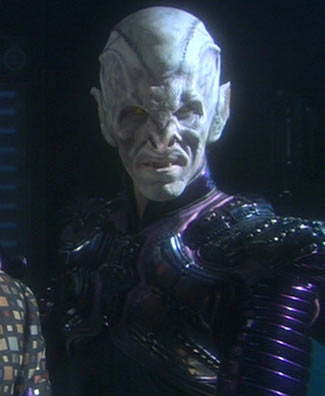
The Remans were the slave labor caste of the Romulan people since at least the 22nd century and forced to work in the extremely hazardous dilithium mines of their world. (ENT: "United", "The Aenar"). As Remus was a tidally locked planet, the Remans live on its dark side, and thus were extremely sensitive to light. Some Remans, if not all, possessed telepathic abilities similar to those shown by Vulcans and Betazoids. (Star Trek Nemesis). According to Data, the Reman language was "a most complex language" that utilized pictographs representing certain verb roots. (Star Trek Nemesis). Among the Romulan people, Remans have historically been known as great warriors. As such, Romulan senators often had Reman bodyguards in their employ to intimidate possible opponents. (ENT: "United", "The Aenar"). Remans were used by the Romulan Empire as "cannon fodder" during the Dominion War, and were often deployed in the fiercest engagements.
In 2379, the Remans usurped the power of their Romulan overlords in a military coup, installing their leader, Shinzon (in actuality, a clone of Jean-Luc Picard), as the new Praetor of the Romulan Senate and thus the empire. As an act of war against the Federation, Praetor Shinzon – with his warbird, the Scimitar – then attempted to destroy all life on Earth. However, with the destruction of the Scimitar at the Battle of the Bassen Rift, after Shinzon's supporters on Romulus turned against him, the bid for Reman superiority was prematurely ended. (Star Trek Nemesis)
Romulans:
 - Male Romulan - Tomalok
- Male Romulan - Tomalok
 - Female Romulan (On The Right) - Deanna Troi Face Of The Enemy
- Female Romulan (On The Right) - Deanna Troi Face Of The Enemy
The Romulans were a humanoid race from the planet Romulus in the Alpha Quadrant. The Romulans were biological cousins of Vulcans, as they were descended from those who rejected Surak's reforms during the Time of Awakening. The Romulan Star Empire was the Romulan state and one of the major powers known in the galaxy.
Commander Spock once theorized that Sargon's people may have colonized Vulcan some 600,000 years ago. Sargon believed that Humans and Vulcans (and therefore also Romulans) might even be descendants of their early travelers. (TOS: "Return to Tomorrow"). With the discovery of ancient humanoid progenitors in the 24th century, most humanoid lifeforms in the known galaxy were found to have a "seed" genetic code guiding their evolution to the humanoid form. (TNG: "The Chase")
When Surak's reforms of embracing logical principles and rejecting emotions spread rapidly across Vulcan in the 4th century, a minority rejected Surak's ideals. Those who marched beneath the banner of the raptor, which became the symbol of the Romulan Star Empire, departed Vulcan in the 4th century. Later, some of their descendants established settlements on the planets Calder II, Dessica II, Draken IV, Yadalla Prime, and Barradas III. An ancient offshoot civilization, called the Debrune, at one time existed on Barradas III, but it had died out by the 24th century. (ENT: "Kir'Shara"; TNG: "Gambit, Part I")
At some point, another group settled on twin planets that became known as Romulus and Remus. While Romulus was a Class M planet, Remus was a harsh planet notable only for its dilithium deposits. Once settled, the two worlds became the foundation of an interstellar empire that expanded to many worlds, reaching across some of the Alpha Quadrant. Eventually that power came to be known as the Romulan Star Empire. (TNG: "Gambit, Part I", "Gambit, Part II"; Star Trek Nemesis)
In 2387, a star close to Romulus went supernova. Ambassador Spock attempted to prevent the supernova from striking the planet using red matter, but he was unsuccessful and Romulus was destroyed. A mining vessel, the Narada, survived and was captained by Nero, who exploited the black hole's creation of a time warp into the past to attack Spock's home planet of Vulcan in revenge and planned to destroy all planets of the Federation so that Romulus could be "free" and possibly conquer everywhere else. The first part of Nero's plan was mostly successful as Vulcan and most of the Vulcan species was destroyed. However, the Narada and its crew were destroyed in the Battle of Earth by the crew of the Enterprise led by the James T. Kirk of the new timeline. (Star Trek)
Vulcans:
.jpg/revision/latest?cb=20091117125800&path-prefix=en) - Male Vulcan - Ambassador Spock
- Male Vulcan - Ambassador Spock
 - Female Vulcan - T'Pol
- Female Vulcan - T'Pol
The Vulcans or Vulcanians were a warp capable humanoid species from the planet Vulcan. They are widely known for their logical minds and stoic culture. In 2161, their homeworld became a founding member of the United Federation of Planets. Commander Spock once theorized that Sargon's people may have colonized Vulcan some half a million years ago. Sargon believed that Humans and Vulcans might even be descendants of their early travelers. (TOS: "Return to Tomorrow"). With the discovery of ancient humanoid progenitors in the 24th century, most humanoid lifeforms in the known galaxy were found to have a "seed" genetic code guiding their evolution to the humanoid form. (TNG: "The Chase")
Commander T'Pol revealed, regarding Vulcans and the planet Vulcan, that her "species evolved on this planet." (ENT: "The Forge"). Culturally one of the most fascinating species in the Federation, the Vulcans were once an extremely violent and emotional people (even by Earth standards) who waged almost constant warfare on one another. (TOS: "Balance of Terror"; VOY: "Random Thoughts") Paranoia and homicidal rage were common. (ENT: "Impulse") They believed in a variety of gods, such as war, peace and death. (TNG: "Gambit, Part II") As their level of technology improved, the Vulcans eventually reached a point where their violent nature threatened species extinction. (ENT: "Awakening")
In an effort to avoid this fate, a Vulcan named Surak developed a new philosophy thereby igniting the Time of Awakening. Surak maintained that the root cause of all the problems on Vulcan lay in the uncontrolled outpouring of the people's emotions. His followers swore to live their lives by an ethical system devised by Surak and based purely on logical principles. Emotions were to be controlled and repressed. (TAS: "Yesteryear")
Although this new philosophy spread rapidly across Vulcan, a minority, many of whom were known as "those who march beneath the Raptor's wings", rejected Surak's ideals. A destructive war began including the use of atomic bombs and among the victims was Surak himself. (ENT: "The Forge", "Awakening")
Eventually, however, those who opposed logic left Vulcan and founded colonies elsewhere (TNG: "Gambit, Part I", "Gambit, Part II") – most notably on the planet Romulus, where they founded what eventually became the Romulan Star Empire. (TOS: "Balance of Terror", "The Enterprise Incident"; TNG: "Unification I", "Unification II") At some point in history, the Romulans and the Vulcans engaged in a hundred-year long war against one another. The war was instigated by the actions of a member of the Q Continuum. (VOY: "Death Wish")
Another group that rejected Surak's philosophy was known as the "V'tosh ka'tur" or "Vulcans without logic". The V'tosh ka'tur believed in controlling emotions by allowing themselves to actively experience them rather than suppressing them. Many of these also left Vulcan, and took up a nomadic existence. (ENT: "Fusion")
At least one planet studied by the Federation was inhabited by "proto-Vulcan humanoids" without warp technology or any direct ties to the Vulcans or the Romulans. The Mintakans possessed technology identified as Bronze Age, but their culture was described by Federation scientists as generally peaceful and highly logical, much like their Vulcan brethren. Eventually, an error during a Federation science mission led to the exposure of Mintakans to Federation technology and society, exempting them from the Prime Directive. (TNG: "Who Watches The Watchers")
The Vulcans conducted a series of survey missions to the Sol system, as early as 1957. (ENT: "Carbon Creek"). Vulcans were in fact one of the first species to develop warp drive, though a century passed between the first warp flight and the breaking of the warp 2 barrier. (ENT: "First Flight") T'Pol told Archer that Vulcans "don't share" Humans' "enthusiasm for space exploration," but a Syrrannite on Vulcan advised Archer that this may not be true. (ENT: "Fight or Flight", "The Forge")
The official First Contact between Vulcans and Humans came on April 5, 2063 when a Vulcan survey ship detected the warp flight of Zefram Cochrane's Phoenix. The Vulcans met with Cochrane at his launch site on the day following the flight. (Star Trek: First Contact)
The Vulcans eventually became Earth's "big brothers" in a way, advising Earth officials on how to proceed into the galaxy. The Vulcan High Command considered Humans volatile and similar to Vulcans before the Time of Awakening, and so attempted to slow down Humanity's move into the galaxy until the time was right. (ENT: "Broken Bow", "The Forge")
By the 21st and 22nd centuries, the Vulcans had also made contact with the Cardassians, Trill, Tholians, Klingons, and scores of other races. (DS9: "Destiny"; ENT: "Broken Bow", "Future Tense")
In contrast to their tradition of peaceful exploration, the Vulcans had a long history of border skirmishes with the neighboring Andorians. The Humans helped negotiate a peace between the two over the disputed Class D planetoid, known to the Vulcans as Paan Mokar. (ENT: "Cease Fire")
In the 22nd century, the Vulcan High Command, once in charge only of space exploration and planetary defense, gained much more control over civilian affairs. Under the High Command's leadership, Vulcan policy toward other planets became more aggressive and interventionist, using the ancient monastery at P'Jem to spy on Andorian activities. (ENT: "The Andorian Incident")
Vulcan also became less tolerant of political and philosophical challenges towards the High Command's operations, notably engaging in purges of the Syrrannite group, who claimed that Vulcan society was no longer following the teachings of Surak. These tensions came to a head in the crisis called the Vulcan Reformation, which resulted in the overthrow of the High Command (and its leader, V'Las, who was secretly allied with the Romulans) and a restructuring of the Vulcan government under the leadership of Kuvak and T'Pau. One of the first acts of the new government was to end the policy of holding back Human expansion into the galaxy. (ENT: "The Forge", "Awakening", "Kir'Shara")
As of the 23rd century, Vulcan had never been conquered in its collective memory. That memory goes so far back that Vulcans could not conceive of a conqueror. (TOS: "The Immunity Syndrome")
Trill:
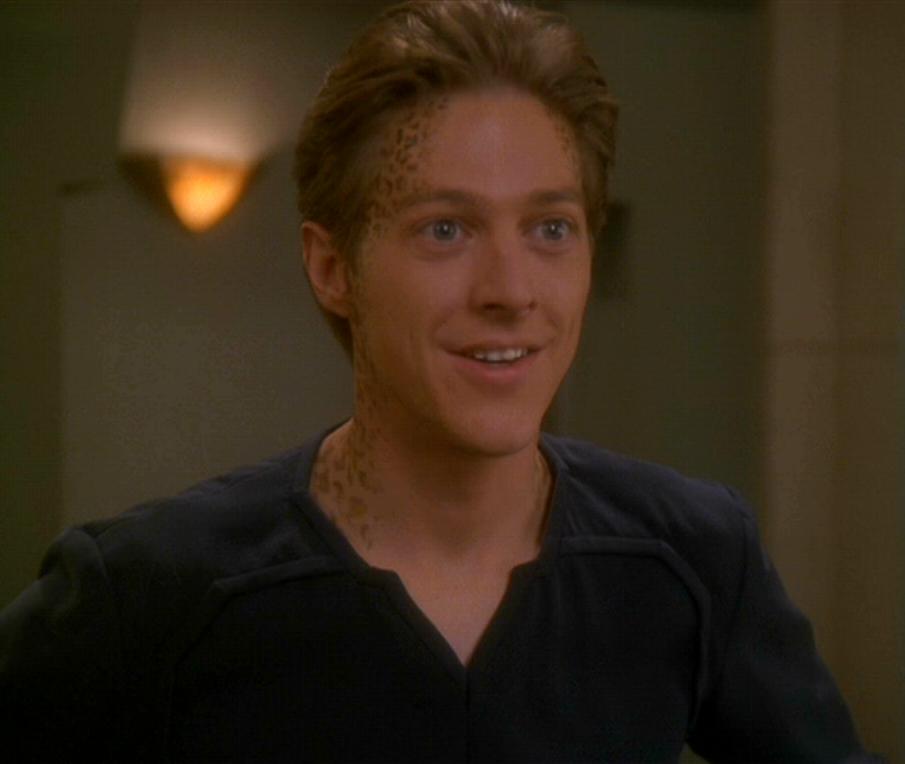 - Male Trill
- Male Trill
 - Female Trill - Jadzia Dax
- Female Trill - Jadzia Dax
 - Trill Symbiont - Odan
- Trill Symbiont - Odan
The Trill (or Trills) were a humanoid species native to the planet Trill. A small percentage of the Trill population co-existed with a sentient symbiotic organism known as a symbiont inside their bodies. The resulting joined Trills had personalities which were a synthesis of the two beings including the memories, and to some extent the personalities, of the previous hosts of the symbiont. This way, the joined being gained all the skills and occupations of the previous hosts. As late as 2367, the fact that some Trills exist as a joined symbiotic species was widely unknown, even to Federation scientists. (TNG: "The Host")
Most Trills are distinguished by two rows of spots going down each side of their bodies, from forehead to toe. Their skin color could vary. One of the main neurotransmitters in the Trill brain is isoboramine. (DS9: "Equilibrium") Joined Trills are also extremely allergic to insect bites; the biochemical connections between the host and symbiont cannot tolerate the reaction caused by the insect's venom. (DS9: "The Siege") One Trill peculiarity is that they are known for having cold hands. (DS9: "A Man Alone")
The few Trills that are given a symbiont are typically joined in their early- to mid-twenties. The physical process of being joined is irreversible. Once joined, the host and symbiont are dependent on each other after ninety-three hours. If the symbiont is removed from the host, symbiont and host will die within hours, even if they are otherwise healthy, unless they are reimplanted with another host or symbiont. (DS9: "Dax", "Invasive Procedures")
The brain of a joined Trill has two cerebral nuclei and two different brain wave patterns. Julian Bashir compared them with two linked computers, which both work for the same task, in 2369. (DS9: "Dax")
Despite the relatively unusual nature of being a joined species, that aspect of their culture was not widely known until 2367, when the Odan symbiont had to be given a new host during the middle of tense negotiations on Peliar Zel. Such a public example of the dual nature of the Trill brought to the forefront what had previously been a very private matter to Trill for several millennia. (TNG: "The Host")
In contrast to the greater revelation of their nature, the Trill are not a secretive species. To them, the joined nature of their culture is normal and not something they would think to comment on without prompting. Indeed, joined Trills can be seen as particularly genial and many have served the Federation as distinguished ambassadors, including Odan and Dax.
Jadzia Dax joked that Trills don't look for romance the way Humans do. Joined Trills consider it quite a nuisance and view it as a weakness of the young. While hosts may have romantic feelings as often as any other sentient species, symbionts try to live on a higher, more spiritual plane and try to rise above those sorts of temptations. (DS9: "A Man Alone")
Trill law forbids reassociation between subsequent hosts of joined persons, whose symbionts were romantically involved in their previous hosts, and the people who the previous hosts were romantically involved with. This is because the main purpose of the transfer of symbionts is to experience new things in life. Trills who are found guilty of reassociation are expelled from Trill society, meaning that their symbionts die with their current host. (DS9: "Rejoined")
The Trill are a technologically advanced species and the Trill Science Ministry is a leading center of learning and experimentation. (DS9: "Rejoined", "In Purgatory's Shadow")
On average, only three hundred symbionts are available for hosting each year and about a thousand Trills apply for joining. Because there are many more humanoid Trills than symbionts, prospective hosts are weeded out by a demanding selection procedure, overseen by the Symbiosis Commission. (DS9: "Equilibrium") The competition for the few symbionts is fierce and attracts the brightest and most highly motivated of Trill society. Often the would-be hosts excel in their chosen fields and it is not uncommon for them to hold several degrees or distinctions prior to their joining. Prospective hosts may eventually become initiates under the supervision of a field docent, a joined Trill who evaluates the prospective host's suitability for joining and makes a recommendation to the Commission. A negative recommendation usually means the initiate is cut from the joining program. (DS9: "Playing God")
Common belief in Trill society holds that only one in a thousand Trills make acceptable hosts. In fact, this figure is vastly understated, and nearly half of the Trill population is capable of being joined. The myth is perpetuated very carefully, though, in order to avoid the widespread chaos which would arise if the information were made public, since the symbionts would become, essentially, objects to be fought over, as people fought to gain the few prized symbionts. (DS9: "Equilibrium")
Unless the joined Trill objects, a prospective host may request a specific symbiont. If a host is weak, the personality of the symbiont will overwhelm it. Joined Trills have several tools at their disposal for dealing with various aspects of their previous hosts. The telepathic ceremony of zhian'tara allows a current host to divest the symbiont of the personality and all the memories of a previous host, which are temporarily hosted in volunteers. The transferring process is performed and supervised by a symbiont Guardian, an unjoined Trill telepath. The ceremony creates a chance for closure by having the new host address the previous hosts directly as a means of distinguishing their voices and cementing the sense of finality of its latest transition. Similarly, the Rite of Emergence can focus the voice of a single previous host among the memories of the other, allowing for a more direct conversation in times of need for the current host.
The zhian'tara ritual is roughly similar to the Vulcan fal-tor-pan ritual, since both enable the respective species to perform a synaptic pattern displacement, the transfer of what could be considered as a soul (katra, pagh, etc.). (DS9: "Invasive Procedures", "Facets", "Field of Fire")
Mintakan:
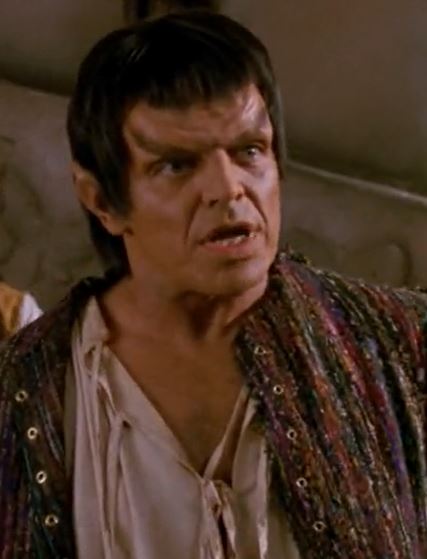 - Male Mintakan
- Male Mintakan
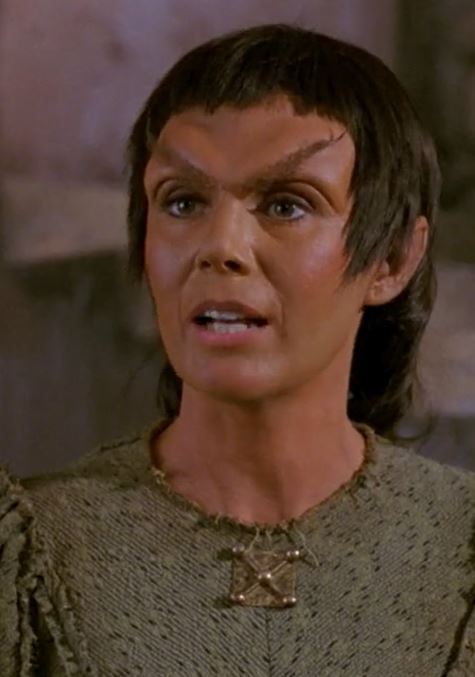 - Female Mintakan
- Female Mintakan
The Mintakans were a proto-Vulcan humanoid species native to Mintaka III, who existed in a Bronze Age state of technology. Once the Mintakans were religious and superstitious and believed in notions such as spirits of the dead haunting the living, supernatural beings or that the stars controlled their fate.
Millennia before 2366, despite their relatively minimal technological advancement, Mintakan culture evolved to highly empirical and had long since rejected the aforementioned superstitions and had been collecting astronomical and archaeological data for several generations.
In 2366, a Federation anthropological team studying the Mintakans, accidentally exposed the primitive culture to 24th century technology when the duck blind they were operating out of had a reactor failure. The USS Enterprise-D responded to the situation and unknowingly worsened the cultural contamination when the Mintakans observed their comings and goings. As a result, the previously discarded beliefs in supernatural beings began to resurface in the village most directly affected. This would eventually lead to their mistaking Jean-Luc Picard for the Overseer, one of their gods. To avert the revival of religion, Captain Picard abducted the local leader, Nuria, in order to give her a guided tour of the ship to explain that the beings they discovered are simply mortals with advanced technology.
Unexpectedly, Nuria believed that this proved that Picard was indeed the Overseer. It took her seeing the death of one of the anthropological team to prove to her that Picard and his people were mortal. When they returned to the planet, Liko finally believed the truth when he almost killed Picard with a bow and arrow.
While cultural contamination occurred, it was relatively limited. The Mintakans gained only the knowledge that sentient life inhabited many worlds besides their own and that many seemingly impossible or divine feats, such as instantaneous transport and interstellar travel, could be achieved with a sufficiently high understanding of technology. The Mintakans were left to continue on something close to their original path of cultural evolution, as the Enterprise crew refused to allow access to advanced technology and explained that the Prime Directive proscribed additional contacts or interference from the Federation and Starfleet until the Mintakans independently became a warp capable culture many years in the future. Mintakan women always walked in front of the men as a sign of ownership, and to stake out a negotiating position for any services that might be asked of the man. (TNG: "Who Watches The Watchers")
Ocampa:
.jpg/revision/latest?cb=20050124224340&path-prefix=en) - Male Ocampa
- Male Ocampa
 - Female Ocampa - Kes
- Female Ocampa - Kes
The Ocampa or Ocampans were a humanoid species who lived on the planet Ocampa in the Delta Quadrant. Their early history was shrouded in mystery but their own legends told of a time when they were capable of great mental feats. (VOY: "Cold Fire", "Shattered")
Some five hundred generations before the 2370s, Nacene explorers from another galaxy inadvertently damaged the atmosphere of the planet Ocampa so badly that all nucleogenic particles were lost, thus rendering the atmosphere incapable of producing rain. The planet rapidly became a desert. The Nacene left two of their kind behind to "honor the debt that could never be repaid" to the Ocampa. The male Nacene, known as the Caretaker to the Ocampa, led the endangered species through tunnels into a vast underground city constructed especially for them. The Caretaker provided them with food, entertainment, water from subterranean sources, and power from the Caretaker's array nearby in space. The Nacene then sealed the Ocampa in, using a force barrier. The Ocampa ruling Elders were subsequently charged with discovering the wishes of the Caretaker, who had become almost a deity to the Ocampan populace. The Ocampa remained in this state for five hundred generations.
By 2371, a dissident movement had developed among the younger generations of Ocampa. They moved out of the city and began to provide for themselves. They were fascinated by ancient stories stating that the Ocampa had once had extraordinary mental capacities. The Elders claimed that the stories were apocryphal, but the dissidents believed these mental powers had only become dormant after centuries of dependence on the Caretaker. In that same year, their reliance on the Caretaker was forcibly ended by the entity's death and the destruction of the array. They had enough energy in the city's reserves to last until 2376 – then they would be forced to return to the planet's surface. (VOY: "Caretaker")
In 2072, the female Nacene, called Suspiria by the Ocampa, decided to leave her mate to seek out "more interesting places." She took several hundred Ocampa with her. Under Suspiria's guidance, these Ocampa developed their mental talents and created technology capable of increasing their natural life spans. Sadly, they also lost some of the Ocampa's native kindness, becoming arrogant and dangerous.
The Ocampa are humanoid and resemble Humans except for a few folds of skin around their ears. They are born without the ear folds, which grow when the infants grow older. They age very rapidly, resulting in an average life span of only nine years. Consequently, they develop and learn extremely quickly. Most of their growth takes place in the first six months, and by one year old, they have reached a young adult stage. They remain in this stage for several years.
Between the ages of four and five, female Ocampa enter the elogium, the time of sexual maturation. During the elogium, a mitral sac forms on the back of the female. The sac accommodates a developing child (or children), and it is from the sac that the child will be born, as its mother stands upright.
Ocampan babies come out of the mitral sac feet first and with an evident navel, suggesting that an umbilical cord detaches from the abdomen during or shortly before birth. (VOY: "Before and After"). The ipasaphor, a sticky yellow substance, appears on the female's hands for the six-day mating bond. Once the ipasaphor has appeared, mating must commence within fifty-two hours. (VOY: "Elogium", "Before and After")
Having remained young-looking for a number of years, they reach middle age sometime around their seventh year. Again, their aging seems to stop, only to rapidly increase near their ninth year with the onset of the morilogium. At this stage of life, the Ocampa move from middle-age to extreme old-age in the space of a few weeks, becoming confused and amnesiac before dying. (VOY: "Before and After")
It is interesting to note that the rapid development and aging is a dominant trait. It is found in half- and even quarter-Ocampa. (VOY: "Before and After"). Ocampa have a body temperature of around sixteen to seventeen degrees Celsius. (VOY: "Before and After"). The Ocampa on Suspiria's array could reach the age of twenty years, with the use of technology to prolong their lives. (VOY: "Cold Fire")
Note: Ocampas who impress Dragons, Whers, or Ridden Phoenix's live the normal length of a human.
Talaxian:
 - Male Talaxian - Neelix
- Male Talaxian - Neelix
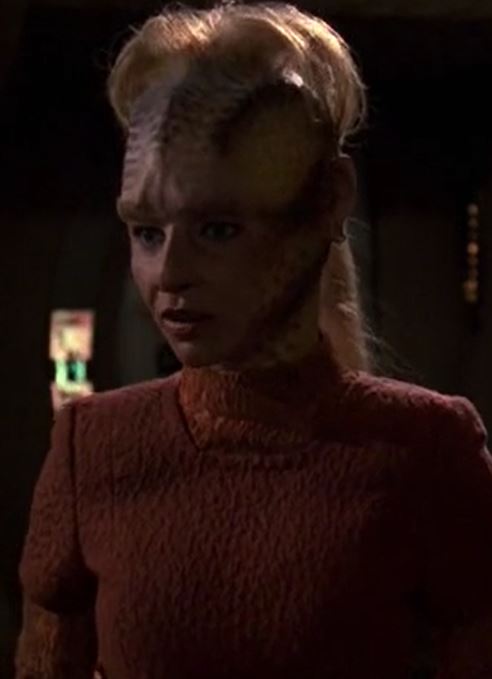 - Female Talaxian
- Female Talaxian
Talaxians were a warp capable, technologically-advanced species native to the planet Talax in the Delta Quadrant. The Talaxian race was an ancient one and they may have been warp capable as far back as the 1450s, when their race was contacted by the Vaadwaur. It was unclear as to how this contact went, however a legacy of this contact survived in the Talaxian language as the word "vaadwaur", which meant "foolish" – later interpreted by historians as being a reference to the fact that it was foolish to trust the Vaadwaur – seemingly suggesting it did not go well. The ancient Talaxians referred to themselves as Talax-ilzay. (VOY: "Dragon's Teeth")
The Talaxian race engaged in a war with the Haakonian Order in the 2340s and 2350s. As a result of the war, many Talaxians emigrated to different regions of the Delta Quadrant. At least one group of emigrants had reached as far as the Delta/Beta Quadrant boundary. The war ended in 2356 with the deployment of the metreon cascade on the Talaxian moon of Rinax. Seeing the devastation caused by the cascade, the Talaxian government surrendered unconditionally. (VOY: "Jetrel", "Homestead")
The Borg referred to Talaxians as Species 218. A small freighter was encountered by the Borg in the Dalmine Sector. The crew of 39 was easily assimilated. (VOY: "The Raven"). A small fleet of Talaxians aided Tom Paris in retaking USS Voyager from the Kazon-Nistrim in 2373. They lured the captured ship into a nebula where Paris, with his shuttle, disabled critical systems, forcing the Kazon to abandon the ship. (VOY: "Basics, Part II")
Five years later, Voyager encountered a colony of Talaxians, of at least five hundred people, living in an asteroid. They were wary of visitors and were plagued by miners who tried to drive them out. Neelix, the morale officer of Voyager, assisted them by putting a plan in motion to place shield generators at key points around the asteroid. This successfully repelled the miners from evicting the Talaxians from the asteroid. Neelix later returned to the colony and assumed a post as Federation ambassador to the Delta Quadrant. (VOY: "Homestead")
The Traveler:
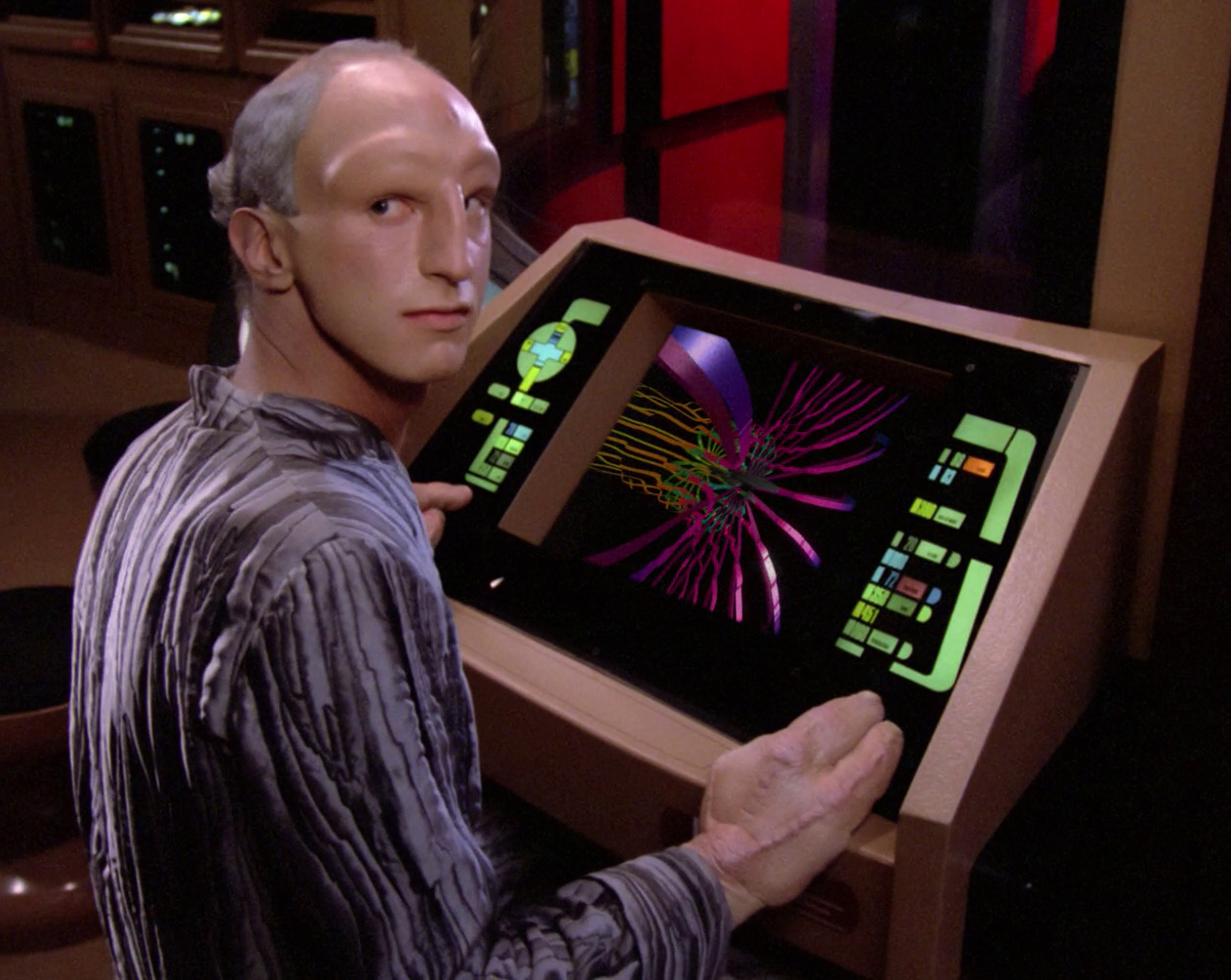
The Traveler, whose real name was unpronounceable by Humans, was a mysterious humanoid native to Tau Alpha C and from Tau Ceti, who had the ability to alter space, time and warp fields with the power of his mind. He could phase out of time and dimension and move between planets and starships. These abilities were based on his ability to focus the energy of thoughts and in his advanced understanding of the nature of reality. According to The Traveler, thought was the basis of all reality. In addition, Deanna Troi noted that his presence could not be detected with the empathic abilities of Betazoids. He could also shapeshift to appear as humanoids from other species with different clothing. (TNG: "Where No One Has Gone Before", "Journey's End")
In 2364, The Traveler became an assistant to Starfleet propulsion expert Kosinski, who claimed to have discovered a revolutionary new method of warp drive. Kosinski's formulas turned out to be bogus, as Wesley Crusher discovered that it was actually Kosinski's assistant, The Traveler, who was the driving force behind the propulsion method. Things went astray, however, and the USS Enterprise-D was catapulted to millions of light years to the M-33 Galaxy. Later, while attempting to return back to the Milky Way Galaxy, the Enterprise instead traveled to end of the universe, a billion light years away. The Traveler collapsed in exhaustion and was taken to sickbay, where he revealed the secret of his abilities. He eventually returned to engineering, where he helped return the ship and crew home to the Milky Way Galaxy.
The Traveler noticed something special about the young Wesley Crusher, comparing him to a young Mozart. Inspired in part by this, Captain Picard promoted Wesley to an acting ensign in the traditions of Starfleet. The Traveler played a significant role in the destiny of Wesley Crusher. (TNG: "Where No One Has Gone Before")
In 2365, when the Enterprise encountered a duplicate version of Captain Picard, apparently transported six hours back in time, the contemporary Captain Picard briefly suspected The Traveler as a cause of this anomaly - noting that The Traveler was capable of movement through time using the power of his mind. Commander Riker, perhaps recalling The Traveler's largely benign nature, did not share this suspicion. (TNG: "Time Squared")
The Traveler was next encountered by the Enterprise crew in 2367, after a "warp bubble" experiment by Wesley Crusher went awry, trapping his mother Beverly Crusher in her own universe. The Traveler appeared and directed the crew on her rescue. He did not solve the problem himself; instead, he urged Wesley to concentrate his own thoughts in order to facilitate the rescue. They succeed in rescuing the elder Crusher, while the younger Crusher continued his maturation. (TNG: "Remember Me")
In 2370, The Traveler appeared incognito as Lakanta, a villager on Dorvan V, to Wesley Crusher. Lakanta, who seemed to have intimate knowledge of Wesley, directed him to seek the answers to his troubled destiny. Wesley was, at the time, quite uncertain about his future in Starfleet. The Traveler guided Wes to the "habak" where Wesley had a vision of his deceased father telling him that his destiny lay somewhere other than with Starfleet. The cadet heeded the advice and resigned from Starfleet, after which in the middle of a riot he managed to dissociate himself from time; it is then that The Traveler revealed his true identity and promised to mentor the young man on his new journey. (TNG: "Journey's End")
Maquis:
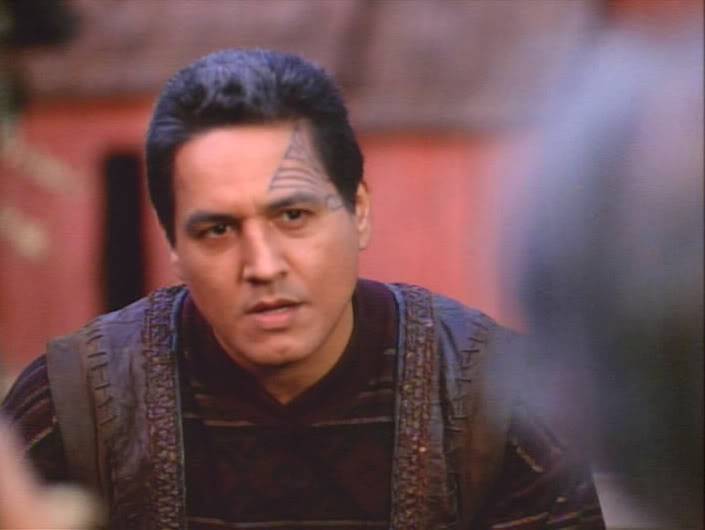 - Male Maquis - Chakotay
- Male Maquis - Chakotay
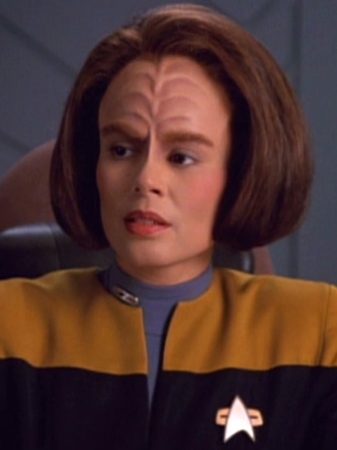 - Female Maquis - B'Elanna
- Female Maquis - B'Elanna
In the normal realm of Star Trek the Maquis are just a resistance group, however in our fandom and world the Maquis are a complete race made of many different species, including Humans, Klingon's, Romulan, Vulcan's, and many more; the planet that was attacked by the Cardassians in the Demilitarized Zone was their Secondary Homeworld, however very few know where their Primary Homeworld is.
Many of the Human Maquis are Native American choosing to follow their roots refusing to take modern ways beyond living in houses. They are ruled by a Governor who lives in a house hidden deep in a large area of woods. The Main Maquis Academy is located here and takes up a minimum of 300 acres.
Note: Speak to our Admin Akadeanna to know where the Primary Homeworld is.
Caitian:
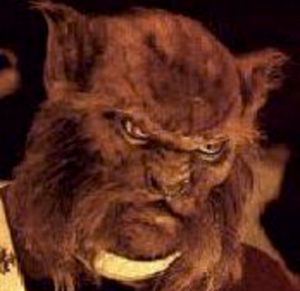 - Male Caitian
- Male Caitian
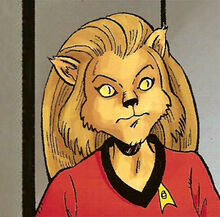 - Female Caitian
- Female Caitian
The feline appearance of Caitians included long manes and a tail. While the skin of some Caitians was covered with fur that varied in color from orange to black, other Caitians were without fur or trimed down completely. Female Caitians grew long human-like hair on their heads. (Star Trek: The Animated Series; Star Trek IV: The Voyage Home; Star Trek Into Darkness) The voices females speak with have a soft, cat-like purring quality. Some Caitians did not find it necessary to use footwear. (Star Trek: The Animated Series)
As the Caitian homeworld was a Federation member, Caitians are known to serve in Starfleet and on the Federation Council, and were present as members in 2286. (Star Trek IV: The Voyage Home)
Any missed races speak to our admin
Andorians:
 - Male Andorian
- Male Andorian - Female Andorian
- Female AndorianAndorians are a humanoid species with blue skin and antennae. They consider themselves a warrior race, in contrast with the pacifist Aenar who also live on the Andoria. They are native to the moon Andoria, which orbits the planet Andor. They were a founding member of the United Federation of Planets.
Bajorans:
 - Male Bajoran
- Male Bajoran - Female Bajoran - Kira Nerys
- Female Bajoran - Kira NerysThe Bajorans are a humanoid species with characteristic nose creases. They live on the planet Bajor. They are a deeply spiritual people, who worship The Prophets. They are enemies of the Cardassians, who occupied Bajor and treated the Bajorans as slaves in the early 24th century.
Benzite's

Benzites are a humanoid race from the planet Benzar and members of the United Federation of Planets. Benzites possess smooth, hairless skin; it may range in color from bluish-purple to green-blue. A thick protrusion of the Benzite skull extends down over the face, displaying a prominent nasal lobe and brow. Two fish-like barbels droop down from above the upper lip. Benzites are highly resistant to poisons and other noxious substances. They can digest and derive nutrition from almost any organic compound. All Benzites from the same geostructure are physically similar, so much so that they are indistinguishable to a non-Benzite.
Betazoids:
 - Male Betazoid
- Male Betazoid.jpg/revision/latest?cb=20120409065643&path-prefix=en) - Female Betazoid - Deanna Troi
- Female Betazoid - Deanna TroiThe Betazoid are a humanoid species, originating from the planet Betazed. They are telepathic and are members of the United Federation of Planets.
Cardassians (Only Accepted On A Case-To-Case Basis):
 - Male Cardassian Garak
- Male Cardassian Garak - Female Cardassian
- Female CardassianThe Cardassians were a humanoid species from the Alpha Quadrant. They were native to the planet Cardassia Prime, capital world of the Cardassian Union. Known throughout the Alpha Quadrant for their ruthlessness, the Cardassians became one of the greatest enemies of the United Federation of Planets and Klingon Empire when they joined the Dominion in 2373. Their xenophobic attitude towards other species was well established throughout the quadrant after the Setlik III massacre during the Cardassian War, as well as when their atrocities during the Occupation of Bajor were revealed after their withdrawal in 2369.
Changeling/Founder/Dominion (Only Accepted On A Case-To-Case Basis):
 - Male Changeling/Founder/Dominion - Odo
- Male Changeling/Founder/Dominion - Odo - Female Changeling/Founder/Dominion
- Female Changeling/Founder/DominionChangelings were at least partially composed of morphogenic enzymes, the molecules responsible for their shapeshifting ability. (DS9: "Things Past"). Common characteristics of Changelings included their biomolecular structure and morphogenic matrix. In its natural state, a Changeling's body was a formless gelatinous mass, to which it had to revert every eighteen hours (Odo's example) in order to regenerate. (DS9: "The Forsaken", "The Storyteller", "The Alternate", "In Purgatory's Shadow"). If a Changeling remained in solid form for longer than sixteen hours, their body began to deteriorate and peel or "flake' away.
El-Aurian:
 - Male El-Aurian - Dr. Tolian Soran
- Male El-Aurian - Dr. Tolian Soran - Female El-Aurian - Guinan
- Female El-Aurian - GuinanEl-Aurians (referred to as a Race of Listeners by Dr. Tolian Soran, the El-Aurian antagonist in Star Trek Generations) are a humanoid race first introduced in the second season of Star Trek: The Next Generation with the character of Guinan. The species was named in the Star Trek: Deep Space Nine episode "Rivals".
El-Aurians are physically similar to humans, but they can live well over 700 years and have a variety of ethnic types, with both dark- and light-skinned members of the race being shown on various Star Trek movies and television episodes. They are considered a race of listeners and often appear patient and wise.
The El-Aurian homeworld was located in the Delta Quadrant and was destroyed by the Borg in the mid-23rd century. Few survived, and those who did were scattered throughout the galaxy. Some of the refugees came to the United Federation of Planets and it has been noted that this is likely an analogy for the spread of Africans around the Earth via colonialism and slavery.
Ferengi (Only Accepted On A Case-To-Case Basis As Candidates, Weyrlings, & Dragonriders; must have a stellar application to be a Candidate; think like a Queen Rider/Candidate on a Canon Weyr):
 - Male Ferengi - Nog
- Male Ferengi - Nog - Female Ferengi
- Female FerengiThe Ferengi were a warp capable humanoid species from the Alpha Quadrant. They originated from planet Ferenginar. Ferengi civilization was built on a caricature of free enterprise, where earning profit was the sole meaningful goal in life, superseding all other endeavors.
The Ferengi governing body, known as the Ferengi Alliance, was formed over a period of ten thousand years, beginning with the establishment of a system of currency, to their purchase of warp technology, and finally to its state in the 24th century. (DS9: "Little Green Men")
Humans (Earth familiar ones):
 - Male Human - Captain Jean-Luc Picard
- Male Human - Captain Jean-Luc Picard - Female Human - Lieutenant Tasha (Natasha) Yar - Deceased
- Female Human - Lieutenant Tasha (Natasha) Yar - DeceasedHumans (Homo sapiens), also known as Terrans, were a warp capable humanoid species from the Alpha Quadrant. The species originated from the planet Earth in the Sol system. Humans were the only surviving race of several sentient/intelligent species to have evolved from the Genus Homo. Humans were also one of two known spacefaring intelligent species to have originated from Earth; the other being the Voth, who had come to live in the Delta Quadrant by the 24th century.
As the Latin word for their homeworld was "Terra", Humans were sometimes referred to as "Terrans", but not always. (This usage was consistent in the mirror universe.) Occasionally the term Terran was used to distinguish Humans living on Earth from those resident on colonies on other planets and moons. Some people used the adjective "Terran" to refer to subjects or institutions associated with Humanity (Terran cuisine, Terran literature, Terran art, etc.). The Borg designation for Humans was Species 5618. (VOY: "Dark Frontier")
A founding member of the United Federation of Planets, Humans of Earth became warp capable in 2063, which was the same year they experienced first official contact with an alien species, the Vulcans. The first warp-drive was engaged on April 5th of that year by Zefram Cochrane. (Star Trek: First Contact; ENT: "Broken Bow", "Desert Crossing", "E²"; VOY: "Year of Hell", "Relativity", "Homestead"). These are the ones that the original settlers on Pern Originated from and the current main Species on Earth.
Klingons:
 - Male Klingon - K'mtar
- Male Klingon - K'mtar - Female Klingon
- Female KlingonThe Klingons were a humanoid warrior species that originated from the planet Qo'noS (pronounced Kronos), an M-class planet. One of the major powers of the galaxy, the Klingons were a proud, tradition-bound people who valued honor and combat. The aggressive Klingon culture had made them an interstellar military power to be respected and feared.
The Klingon Empire was founded some time in the 9th century by Kahless the Unforgettable, who performed many heroic feats including the unification of the Klingon people when he killed the tyrant Molor. Kahless came to be revered in Klingon society to the point of near-deification, and many aspects of Klingon culture came to revolve around an emulation of Kahless' life. (TNG: "Rightful Heir")
The warrior ethos had been an important aspect of Klingon society since the time of Kahless, but the warrior aspects became much more dominant beginning in the early 22nd century. Previously, Klingon society was regarded as socially balanced, but over time, the warrior caste gained greater prominence, to the point where the Klingons widely came to be regarded as a "warrior race." (ENT: "Broken Bow", "Judgment")
Because of their aggressive outlook, the Klingons generally had poor relations with other races after they began to move out into space. Because the worlds of the Klingon Empire were resource-poor, the Klingons developed an intense belief in the need for expansion and conquest in order to survive. The Klingons' relationship with Humans and the Federation was rocky at best. Following the disastrous first contact between Klingons and Humans in the Broken Bow incident, tense rivalries and unavoidable conflicts often developed between the two races. (ENT: "Broken Bow"; TNG: "First Contact")
In the year 2154, the Klingons gained access to the genetic material of Human Augments and tried to adapt this genetic engineering to improve themselves. The test subjects did gain increased strength and intelligence, but then, their neural pathways started to degrade and they died in agony. One of the subjects suffered from the Levodian flu, which was modified by the Augment DNA to become a fatal, airborne, mutagenic plague that spread rampantly through the Empire, from world to world. In the first stage of this plague, Klingons lost the ridges on their foreheads and began to look more Human. With the help of a Klingon scientist named Antaak, Dr. Phlox of the Earth starship Enterprise was able to formulate a cure that halted the genetic effects of the virus in the first stage. This retained the changes in appearance, along with some minor neural re-ordering. The neural ordering caused changes in the emotional make-up of the Klingons. For example, the infected started to feel fear. Even though the infected did not develop any stage-two characteristics – such as enhanced strength, speed, or endurance – they did not die from it. This left millions of Klingons changed. These alterations were even passed on to their children. (ENT: "Affliction", "Divergence") From the 2270s onward, Klingons encountered by the Federation had their forehead ridges restored. (Star Trek: The Motion Picture)
Klingons were apparently so embarrassed by the fallout from their failed attempt at genetic enhancement that they refused to discuss the incident with outsiders. Due to the secrecy of the Klingon Empire, knowledge of the change became lost over time to the general population of the Federation. By the 24th century, the reason for smooth-forehead Klingons was not widely known outside the Empire, and questions were generally met with a brusque answer along the lines of, "We don't discuss it with outsiders." (ENT: "Affliction", "Divergence"; DS9: "Trials and Tribble-ations"). By 2223, relations between the Federation and the Klingon Empire degenerated to a point of relentless hostility, which lasted for several decades. (Star Trek VI: The Undiscovered Country; TNG: "First Contact")
The lingering tensions between Klingons and Humans continued to rise, eventually leading to the Battle of Donatu V, near Sherman's Planet in 2245, and later erupted into what was considered the Federation-Klingon War of 2267. This war was quickly ended by intervention by the Organians, after only four days of fighting. (TOS: "The Trouble with Tribbles", "Errand of Mercy") Over the next several decades, an uneasy peace developed that was broken by brief but fierce skirmishes and conflicts (Star Trek III: The Search for Spock; Star Trek V: The Final Frontier). A true and lasting peace finally came in 2293, with the signing of the Khitomer Accords, thanks to the efforts of Chancellor Gorkon and the Human Starfleet officer James T. Kirk. (Star Trek VI: The Undiscovered Country) Since then, despite several periods of rocky relations (see Federation-Klingon War (2372-73)), the Federation and the Klingon Empire have been steadfast allies, especially in the face of Dominion aggression in the 2370s. (DS9: "The Way of the Warrior", "By Inferno's Light")
The Klingon relationship with the Romulan people was also extremely unstable. A short-lived alliance and technology exchange notwithstanding, the Romulan Star Empire was typically regarded by the Klingons as a "blood enemy" since at least the 23rd century. Sporadic Romulan attacks against Klingon colonies (see Khitomer Massacre) and interference in Klingon affairs (see Klingon Civil War) continued to sour relationships between the two peoples. (TNG: "Sins of the Father", "Redemption II")
Reman's (ONLY Allowed To Impress Wher's Due To Their Light Sensitivity):

The Remans were the slave labor caste of the Romulan people since at least the 22nd century and forced to work in the extremely hazardous dilithium mines of their world. (ENT: "United", "The Aenar"). As Remus was a tidally locked planet, the Remans live on its dark side, and thus were extremely sensitive to light. Some Remans, if not all, possessed telepathic abilities similar to those shown by Vulcans and Betazoids. (Star Trek Nemesis). According to Data, the Reman language was "a most complex language" that utilized pictographs representing certain verb roots. (Star Trek Nemesis). Among the Romulan people, Remans have historically been known as great warriors. As such, Romulan senators often had Reman bodyguards in their employ to intimidate possible opponents. (ENT: "United", "The Aenar"). Remans were used by the Romulan Empire as "cannon fodder" during the Dominion War, and were often deployed in the fiercest engagements.
In 2379, the Remans usurped the power of their Romulan overlords in a military coup, installing their leader, Shinzon (in actuality, a clone of Jean-Luc Picard), as the new Praetor of the Romulan Senate and thus the empire. As an act of war against the Federation, Praetor Shinzon – with his warbird, the Scimitar – then attempted to destroy all life on Earth. However, with the destruction of the Scimitar at the Battle of the Bassen Rift, after Shinzon's supporters on Romulus turned against him, the bid for Reman superiority was prematurely ended. (Star Trek Nemesis)
Romulans:
 - Male Romulan - Tomalok
- Male Romulan - Tomalok - Female Romulan (On The Right) - Deanna Troi Face Of The Enemy
- Female Romulan (On The Right) - Deanna Troi Face Of The EnemyThe Romulans were a humanoid race from the planet Romulus in the Alpha Quadrant. The Romulans were biological cousins of Vulcans, as they were descended from those who rejected Surak's reforms during the Time of Awakening. The Romulan Star Empire was the Romulan state and one of the major powers known in the galaxy.
Commander Spock once theorized that Sargon's people may have colonized Vulcan some 600,000 years ago. Sargon believed that Humans and Vulcans (and therefore also Romulans) might even be descendants of their early travelers. (TOS: "Return to Tomorrow"). With the discovery of ancient humanoid progenitors in the 24th century, most humanoid lifeforms in the known galaxy were found to have a "seed" genetic code guiding their evolution to the humanoid form. (TNG: "The Chase")
When Surak's reforms of embracing logical principles and rejecting emotions spread rapidly across Vulcan in the 4th century, a minority rejected Surak's ideals. Those who marched beneath the banner of the raptor, which became the symbol of the Romulan Star Empire, departed Vulcan in the 4th century. Later, some of their descendants established settlements on the planets Calder II, Dessica II, Draken IV, Yadalla Prime, and Barradas III. An ancient offshoot civilization, called the Debrune, at one time existed on Barradas III, but it had died out by the 24th century. (ENT: "Kir'Shara"; TNG: "Gambit, Part I")
At some point, another group settled on twin planets that became known as Romulus and Remus. While Romulus was a Class M planet, Remus was a harsh planet notable only for its dilithium deposits. Once settled, the two worlds became the foundation of an interstellar empire that expanded to many worlds, reaching across some of the Alpha Quadrant. Eventually that power came to be known as the Romulan Star Empire. (TNG: "Gambit, Part I", "Gambit, Part II"; Star Trek Nemesis)
In 2387, a star close to Romulus went supernova. Ambassador Spock attempted to prevent the supernova from striking the planet using red matter, but he was unsuccessful and Romulus was destroyed. A mining vessel, the Narada, survived and was captained by Nero, who exploited the black hole's creation of a time warp into the past to attack Spock's home planet of Vulcan in revenge and planned to destroy all planets of the Federation so that Romulus could be "free" and possibly conquer everywhere else. The first part of Nero's plan was mostly successful as Vulcan and most of the Vulcan species was destroyed. However, the Narada and its crew were destroyed in the Battle of Earth by the crew of the Enterprise led by the James T. Kirk of the new timeline. (Star Trek)
Vulcans:
.jpg/revision/latest?cb=20091117125800&path-prefix=en) - Male Vulcan - Ambassador Spock
- Male Vulcan - Ambassador Spock - Female Vulcan - T'Pol
- Female Vulcan - T'PolThe Vulcans or Vulcanians were a warp capable humanoid species from the planet Vulcan. They are widely known for their logical minds and stoic culture. In 2161, their homeworld became a founding member of the United Federation of Planets. Commander Spock once theorized that Sargon's people may have colonized Vulcan some half a million years ago. Sargon believed that Humans and Vulcans might even be descendants of their early travelers. (TOS: "Return to Tomorrow"). With the discovery of ancient humanoid progenitors in the 24th century, most humanoid lifeforms in the known galaxy were found to have a "seed" genetic code guiding their evolution to the humanoid form. (TNG: "The Chase")
Commander T'Pol revealed, regarding Vulcans and the planet Vulcan, that her "species evolved on this planet." (ENT: "The Forge"). Culturally one of the most fascinating species in the Federation, the Vulcans were once an extremely violent and emotional people (even by Earth standards) who waged almost constant warfare on one another. (TOS: "Balance of Terror"; VOY: "Random Thoughts") Paranoia and homicidal rage were common. (ENT: "Impulse") They believed in a variety of gods, such as war, peace and death. (TNG: "Gambit, Part II") As their level of technology improved, the Vulcans eventually reached a point where their violent nature threatened species extinction. (ENT: "Awakening")
In an effort to avoid this fate, a Vulcan named Surak developed a new philosophy thereby igniting the Time of Awakening. Surak maintained that the root cause of all the problems on Vulcan lay in the uncontrolled outpouring of the people's emotions. His followers swore to live their lives by an ethical system devised by Surak and based purely on logical principles. Emotions were to be controlled and repressed. (TAS: "Yesteryear")
Although this new philosophy spread rapidly across Vulcan, a minority, many of whom were known as "those who march beneath the Raptor's wings", rejected Surak's ideals. A destructive war began including the use of atomic bombs and among the victims was Surak himself. (ENT: "The Forge", "Awakening")
Eventually, however, those who opposed logic left Vulcan and founded colonies elsewhere (TNG: "Gambit, Part I", "Gambit, Part II") – most notably on the planet Romulus, where they founded what eventually became the Romulan Star Empire. (TOS: "Balance of Terror", "The Enterprise Incident"; TNG: "Unification I", "Unification II") At some point in history, the Romulans and the Vulcans engaged in a hundred-year long war against one another. The war was instigated by the actions of a member of the Q Continuum. (VOY: "Death Wish")
Another group that rejected Surak's philosophy was known as the "V'tosh ka'tur" or "Vulcans without logic". The V'tosh ka'tur believed in controlling emotions by allowing themselves to actively experience them rather than suppressing them. Many of these also left Vulcan, and took up a nomadic existence. (ENT: "Fusion")
At least one planet studied by the Federation was inhabited by "proto-Vulcan humanoids" without warp technology or any direct ties to the Vulcans or the Romulans. The Mintakans possessed technology identified as Bronze Age, but their culture was described by Federation scientists as generally peaceful and highly logical, much like their Vulcan brethren. Eventually, an error during a Federation science mission led to the exposure of Mintakans to Federation technology and society, exempting them from the Prime Directive. (TNG: "Who Watches The Watchers")
The Vulcans conducted a series of survey missions to the Sol system, as early as 1957. (ENT: "Carbon Creek"). Vulcans were in fact one of the first species to develop warp drive, though a century passed between the first warp flight and the breaking of the warp 2 barrier. (ENT: "First Flight") T'Pol told Archer that Vulcans "don't share" Humans' "enthusiasm for space exploration," but a Syrrannite on Vulcan advised Archer that this may not be true. (ENT: "Fight or Flight", "The Forge")
The official First Contact between Vulcans and Humans came on April 5, 2063 when a Vulcan survey ship detected the warp flight of Zefram Cochrane's Phoenix. The Vulcans met with Cochrane at his launch site on the day following the flight. (Star Trek: First Contact)
The Vulcans eventually became Earth's "big brothers" in a way, advising Earth officials on how to proceed into the galaxy. The Vulcan High Command considered Humans volatile and similar to Vulcans before the Time of Awakening, and so attempted to slow down Humanity's move into the galaxy until the time was right. (ENT: "Broken Bow", "The Forge")
By the 21st and 22nd centuries, the Vulcans had also made contact with the Cardassians, Trill, Tholians, Klingons, and scores of other races. (DS9: "Destiny"; ENT: "Broken Bow", "Future Tense")
In contrast to their tradition of peaceful exploration, the Vulcans had a long history of border skirmishes with the neighboring Andorians. The Humans helped negotiate a peace between the two over the disputed Class D planetoid, known to the Vulcans as Paan Mokar. (ENT: "Cease Fire")
In the 22nd century, the Vulcan High Command, once in charge only of space exploration and planetary defense, gained much more control over civilian affairs. Under the High Command's leadership, Vulcan policy toward other planets became more aggressive and interventionist, using the ancient monastery at P'Jem to spy on Andorian activities. (ENT: "The Andorian Incident")
Vulcan also became less tolerant of political and philosophical challenges towards the High Command's operations, notably engaging in purges of the Syrrannite group, who claimed that Vulcan society was no longer following the teachings of Surak. These tensions came to a head in the crisis called the Vulcan Reformation, which resulted in the overthrow of the High Command (and its leader, V'Las, who was secretly allied with the Romulans) and a restructuring of the Vulcan government under the leadership of Kuvak and T'Pau. One of the first acts of the new government was to end the policy of holding back Human expansion into the galaxy. (ENT: "The Forge", "Awakening", "Kir'Shara")
As of the 23rd century, Vulcan had never been conquered in its collective memory. That memory goes so far back that Vulcans could not conceive of a conqueror. (TOS: "The Immunity Syndrome")
Trill:
 - Male Trill
- Male Trill - Female Trill - Jadzia Dax
- Female Trill - Jadzia Dax - Trill Symbiont - Odan
- Trill Symbiont - OdanThe Trill (or Trills) were a humanoid species native to the planet Trill. A small percentage of the Trill population co-existed with a sentient symbiotic organism known as a symbiont inside their bodies. The resulting joined Trills had personalities which were a synthesis of the two beings including the memories, and to some extent the personalities, of the previous hosts of the symbiont. This way, the joined being gained all the skills and occupations of the previous hosts. As late as 2367, the fact that some Trills exist as a joined symbiotic species was widely unknown, even to Federation scientists. (TNG: "The Host")
Most Trills are distinguished by two rows of spots going down each side of their bodies, from forehead to toe. Their skin color could vary. One of the main neurotransmitters in the Trill brain is isoboramine. (DS9: "Equilibrium") Joined Trills are also extremely allergic to insect bites; the biochemical connections between the host and symbiont cannot tolerate the reaction caused by the insect's venom. (DS9: "The Siege") One Trill peculiarity is that they are known for having cold hands. (DS9: "A Man Alone")
The few Trills that are given a symbiont are typically joined in their early- to mid-twenties. The physical process of being joined is irreversible. Once joined, the host and symbiont are dependent on each other after ninety-three hours. If the symbiont is removed from the host, symbiont and host will die within hours, even if they are otherwise healthy, unless they are reimplanted with another host or symbiont. (DS9: "Dax", "Invasive Procedures")
The brain of a joined Trill has two cerebral nuclei and two different brain wave patterns. Julian Bashir compared them with two linked computers, which both work for the same task, in 2369. (DS9: "Dax")
Despite the relatively unusual nature of being a joined species, that aspect of their culture was not widely known until 2367, when the Odan symbiont had to be given a new host during the middle of tense negotiations on Peliar Zel. Such a public example of the dual nature of the Trill brought to the forefront what had previously been a very private matter to Trill for several millennia. (TNG: "The Host")
In contrast to the greater revelation of their nature, the Trill are not a secretive species. To them, the joined nature of their culture is normal and not something they would think to comment on without prompting. Indeed, joined Trills can be seen as particularly genial and many have served the Federation as distinguished ambassadors, including Odan and Dax.
Jadzia Dax joked that Trills don't look for romance the way Humans do. Joined Trills consider it quite a nuisance and view it as a weakness of the young. While hosts may have romantic feelings as often as any other sentient species, symbionts try to live on a higher, more spiritual plane and try to rise above those sorts of temptations. (DS9: "A Man Alone")
Trill law forbids reassociation between subsequent hosts of joined persons, whose symbionts were romantically involved in their previous hosts, and the people who the previous hosts were romantically involved with. This is because the main purpose of the transfer of symbionts is to experience new things in life. Trills who are found guilty of reassociation are expelled from Trill society, meaning that their symbionts die with their current host. (DS9: "Rejoined")
The Trill are a technologically advanced species and the Trill Science Ministry is a leading center of learning and experimentation. (DS9: "Rejoined", "In Purgatory's Shadow")
On average, only three hundred symbionts are available for hosting each year and about a thousand Trills apply for joining. Because there are many more humanoid Trills than symbionts, prospective hosts are weeded out by a demanding selection procedure, overseen by the Symbiosis Commission. (DS9: "Equilibrium") The competition for the few symbionts is fierce and attracts the brightest and most highly motivated of Trill society. Often the would-be hosts excel in their chosen fields and it is not uncommon for them to hold several degrees or distinctions prior to their joining. Prospective hosts may eventually become initiates under the supervision of a field docent, a joined Trill who evaluates the prospective host's suitability for joining and makes a recommendation to the Commission. A negative recommendation usually means the initiate is cut from the joining program. (DS9: "Playing God")
Common belief in Trill society holds that only one in a thousand Trills make acceptable hosts. In fact, this figure is vastly understated, and nearly half of the Trill population is capable of being joined. The myth is perpetuated very carefully, though, in order to avoid the widespread chaos which would arise if the information were made public, since the symbionts would become, essentially, objects to be fought over, as people fought to gain the few prized symbionts. (DS9: "Equilibrium")
Unless the joined Trill objects, a prospective host may request a specific symbiont. If a host is weak, the personality of the symbiont will overwhelm it. Joined Trills have several tools at their disposal for dealing with various aspects of their previous hosts. The telepathic ceremony of zhian'tara allows a current host to divest the symbiont of the personality and all the memories of a previous host, which are temporarily hosted in volunteers. The transferring process is performed and supervised by a symbiont Guardian, an unjoined Trill telepath. The ceremony creates a chance for closure by having the new host address the previous hosts directly as a means of distinguishing their voices and cementing the sense of finality of its latest transition. Similarly, the Rite of Emergence can focus the voice of a single previous host among the memories of the other, allowing for a more direct conversation in times of need for the current host.
The zhian'tara ritual is roughly similar to the Vulcan fal-tor-pan ritual, since both enable the respective species to perform a synaptic pattern displacement, the transfer of what could be considered as a soul (katra, pagh, etc.). (DS9: "Invasive Procedures", "Facets", "Field of Fire")
Mintakan:
 - Male Mintakan
- Male Mintakan - Female Mintakan
- Female MintakanThe Mintakans were a proto-Vulcan humanoid species native to Mintaka III, who existed in a Bronze Age state of technology. Once the Mintakans were religious and superstitious and believed in notions such as spirits of the dead haunting the living, supernatural beings or that the stars controlled their fate.
Millennia before 2366, despite their relatively minimal technological advancement, Mintakan culture evolved to highly empirical and had long since rejected the aforementioned superstitions and had been collecting astronomical and archaeological data for several generations.
In 2366, a Federation anthropological team studying the Mintakans, accidentally exposed the primitive culture to 24th century technology when the duck blind they were operating out of had a reactor failure. The USS Enterprise-D responded to the situation and unknowingly worsened the cultural contamination when the Mintakans observed their comings and goings. As a result, the previously discarded beliefs in supernatural beings began to resurface in the village most directly affected. This would eventually lead to their mistaking Jean-Luc Picard for the Overseer, one of their gods. To avert the revival of religion, Captain Picard abducted the local leader, Nuria, in order to give her a guided tour of the ship to explain that the beings they discovered are simply mortals with advanced technology.
Unexpectedly, Nuria believed that this proved that Picard was indeed the Overseer. It took her seeing the death of one of the anthropological team to prove to her that Picard and his people were mortal. When they returned to the planet, Liko finally believed the truth when he almost killed Picard with a bow and arrow.
While cultural contamination occurred, it was relatively limited. The Mintakans gained only the knowledge that sentient life inhabited many worlds besides their own and that many seemingly impossible or divine feats, such as instantaneous transport and interstellar travel, could be achieved with a sufficiently high understanding of technology. The Mintakans were left to continue on something close to their original path of cultural evolution, as the Enterprise crew refused to allow access to advanced technology and explained that the Prime Directive proscribed additional contacts or interference from the Federation and Starfleet until the Mintakans independently became a warp capable culture many years in the future. Mintakan women always walked in front of the men as a sign of ownership, and to stake out a negotiating position for any services that might be asked of the man. (TNG: "Who Watches The Watchers")
Ocampa:
.jpg/revision/latest?cb=20050124224340&path-prefix=en) - Male Ocampa
- Male Ocampa - Female Ocampa - Kes
- Female Ocampa - KesThe Ocampa or Ocampans were a humanoid species who lived on the planet Ocampa in the Delta Quadrant. Their early history was shrouded in mystery but their own legends told of a time when they were capable of great mental feats. (VOY: "Cold Fire", "Shattered")
Some five hundred generations before the 2370s, Nacene explorers from another galaxy inadvertently damaged the atmosphere of the planet Ocampa so badly that all nucleogenic particles were lost, thus rendering the atmosphere incapable of producing rain. The planet rapidly became a desert. The Nacene left two of their kind behind to "honor the debt that could never be repaid" to the Ocampa. The male Nacene, known as the Caretaker to the Ocampa, led the endangered species through tunnels into a vast underground city constructed especially for them. The Caretaker provided them with food, entertainment, water from subterranean sources, and power from the Caretaker's array nearby in space. The Nacene then sealed the Ocampa in, using a force barrier. The Ocampa ruling Elders were subsequently charged with discovering the wishes of the Caretaker, who had become almost a deity to the Ocampan populace. The Ocampa remained in this state for five hundred generations.
By 2371, a dissident movement had developed among the younger generations of Ocampa. They moved out of the city and began to provide for themselves. They were fascinated by ancient stories stating that the Ocampa had once had extraordinary mental capacities. The Elders claimed that the stories were apocryphal, but the dissidents believed these mental powers had only become dormant after centuries of dependence on the Caretaker. In that same year, their reliance on the Caretaker was forcibly ended by the entity's death and the destruction of the array. They had enough energy in the city's reserves to last until 2376 – then they would be forced to return to the planet's surface. (VOY: "Caretaker")
In 2072, the female Nacene, called Suspiria by the Ocampa, decided to leave her mate to seek out "more interesting places." She took several hundred Ocampa with her. Under Suspiria's guidance, these Ocampa developed their mental talents and created technology capable of increasing their natural life spans. Sadly, they also lost some of the Ocampa's native kindness, becoming arrogant and dangerous.
The Ocampa are humanoid and resemble Humans except for a few folds of skin around their ears. They are born without the ear folds, which grow when the infants grow older. They age very rapidly, resulting in an average life span of only nine years. Consequently, they develop and learn extremely quickly. Most of their growth takes place in the first six months, and by one year old, they have reached a young adult stage. They remain in this stage for several years.
Between the ages of four and five, female Ocampa enter the elogium, the time of sexual maturation. During the elogium, a mitral sac forms on the back of the female. The sac accommodates a developing child (or children), and it is from the sac that the child will be born, as its mother stands upright.
Ocampan babies come out of the mitral sac feet first and with an evident navel, suggesting that an umbilical cord detaches from the abdomen during or shortly before birth. (VOY: "Before and After"). The ipasaphor, a sticky yellow substance, appears on the female's hands for the six-day mating bond. Once the ipasaphor has appeared, mating must commence within fifty-two hours. (VOY: "Elogium", "Before and After")
Having remained young-looking for a number of years, they reach middle age sometime around their seventh year. Again, their aging seems to stop, only to rapidly increase near their ninth year with the onset of the morilogium. At this stage of life, the Ocampa move from middle-age to extreme old-age in the space of a few weeks, becoming confused and amnesiac before dying. (VOY: "Before and After")
It is interesting to note that the rapid development and aging is a dominant trait. It is found in half- and even quarter-Ocampa. (VOY: "Before and After"). Ocampa have a body temperature of around sixteen to seventeen degrees Celsius. (VOY: "Before and After"). The Ocampa on Suspiria's array could reach the age of twenty years, with the use of technology to prolong their lives. (VOY: "Cold Fire")
Note: Ocampas who impress Dragons, Whers, or Ridden Phoenix's live the normal length of a human.
Talaxian:
 - Male Talaxian - Neelix
- Male Talaxian - Neelix - Female Talaxian
- Female TalaxianTalaxians were a warp capable, technologically-advanced species native to the planet Talax in the Delta Quadrant. The Talaxian race was an ancient one and they may have been warp capable as far back as the 1450s, when their race was contacted by the Vaadwaur. It was unclear as to how this contact went, however a legacy of this contact survived in the Talaxian language as the word "vaadwaur", which meant "foolish" – later interpreted by historians as being a reference to the fact that it was foolish to trust the Vaadwaur – seemingly suggesting it did not go well. The ancient Talaxians referred to themselves as Talax-ilzay. (VOY: "Dragon's Teeth")
The Talaxian race engaged in a war with the Haakonian Order in the 2340s and 2350s. As a result of the war, many Talaxians emigrated to different regions of the Delta Quadrant. At least one group of emigrants had reached as far as the Delta/Beta Quadrant boundary. The war ended in 2356 with the deployment of the metreon cascade on the Talaxian moon of Rinax. Seeing the devastation caused by the cascade, the Talaxian government surrendered unconditionally. (VOY: "Jetrel", "Homestead")
The Borg referred to Talaxians as Species 218. A small freighter was encountered by the Borg in the Dalmine Sector. The crew of 39 was easily assimilated. (VOY: "The Raven"). A small fleet of Talaxians aided Tom Paris in retaking USS Voyager from the Kazon-Nistrim in 2373. They lured the captured ship into a nebula where Paris, with his shuttle, disabled critical systems, forcing the Kazon to abandon the ship. (VOY: "Basics, Part II")
Five years later, Voyager encountered a colony of Talaxians, of at least five hundred people, living in an asteroid. They were wary of visitors and were plagued by miners who tried to drive them out. Neelix, the morale officer of Voyager, assisted them by putting a plan in motion to place shield generators at key points around the asteroid. This successfully repelled the miners from evicting the Talaxians from the asteroid. Neelix later returned to the colony and assumed a post as Federation ambassador to the Delta Quadrant. (VOY: "Homestead")
The Traveler:

The Traveler, whose real name was unpronounceable by Humans, was a mysterious humanoid native to Tau Alpha C and from Tau Ceti, who had the ability to alter space, time and warp fields with the power of his mind. He could phase out of time and dimension and move between planets and starships. These abilities were based on his ability to focus the energy of thoughts and in his advanced understanding of the nature of reality. According to The Traveler, thought was the basis of all reality. In addition, Deanna Troi noted that his presence could not be detected with the empathic abilities of Betazoids. He could also shapeshift to appear as humanoids from other species with different clothing. (TNG: "Where No One Has Gone Before", "Journey's End")
In 2364, The Traveler became an assistant to Starfleet propulsion expert Kosinski, who claimed to have discovered a revolutionary new method of warp drive. Kosinski's formulas turned out to be bogus, as Wesley Crusher discovered that it was actually Kosinski's assistant, The Traveler, who was the driving force behind the propulsion method. Things went astray, however, and the USS Enterprise-D was catapulted to millions of light years to the M-33 Galaxy. Later, while attempting to return back to the Milky Way Galaxy, the Enterprise instead traveled to end of the universe, a billion light years away. The Traveler collapsed in exhaustion and was taken to sickbay, where he revealed the secret of his abilities. He eventually returned to engineering, where he helped return the ship and crew home to the Milky Way Galaxy.
The Traveler noticed something special about the young Wesley Crusher, comparing him to a young Mozart. Inspired in part by this, Captain Picard promoted Wesley to an acting ensign in the traditions of Starfleet. The Traveler played a significant role in the destiny of Wesley Crusher. (TNG: "Where No One Has Gone Before")
In 2365, when the Enterprise encountered a duplicate version of Captain Picard, apparently transported six hours back in time, the contemporary Captain Picard briefly suspected The Traveler as a cause of this anomaly - noting that The Traveler was capable of movement through time using the power of his mind. Commander Riker, perhaps recalling The Traveler's largely benign nature, did not share this suspicion. (TNG: "Time Squared")
The Traveler was next encountered by the Enterprise crew in 2367, after a "warp bubble" experiment by Wesley Crusher went awry, trapping his mother Beverly Crusher in her own universe. The Traveler appeared and directed the crew on her rescue. He did not solve the problem himself; instead, he urged Wesley to concentrate his own thoughts in order to facilitate the rescue. They succeed in rescuing the elder Crusher, while the younger Crusher continued his maturation. (TNG: "Remember Me")
In 2370, The Traveler appeared incognito as Lakanta, a villager on Dorvan V, to Wesley Crusher. Lakanta, who seemed to have intimate knowledge of Wesley, directed him to seek the answers to his troubled destiny. Wesley was, at the time, quite uncertain about his future in Starfleet. The Traveler guided Wes to the "habak" where Wesley had a vision of his deceased father telling him that his destiny lay somewhere other than with Starfleet. The cadet heeded the advice and resigned from Starfleet, after which in the middle of a riot he managed to dissociate himself from time; it is then that The Traveler revealed his true identity and promised to mentor the young man on his new journey. (TNG: "Journey's End")
Maquis:
 - Male Maquis - Chakotay
- Male Maquis - Chakotay - Female Maquis - B'Elanna
- Female Maquis - B'ElannaIn the normal realm of Star Trek the Maquis are just a resistance group, however in our fandom and world the Maquis are a complete race made of many different species, including Humans, Klingon's, Romulan, Vulcan's, and many more; the planet that was attacked by the Cardassians in the Demilitarized Zone was their Secondary Homeworld, however very few know where their Primary Homeworld is.
Many of the Human Maquis are Native American choosing to follow their roots refusing to take modern ways beyond living in houses. They are ruled by a Governor who lives in a house hidden deep in a large area of woods. The Main Maquis Academy is located here and takes up a minimum of 300 acres.
Note: Speak to our Admin Akadeanna to know where the Primary Homeworld is.
Caitian:
 - Male Caitian
- Male Caitian - Female Caitian
- Female CaitianThe feline appearance of Caitians included long manes and a tail. While the skin of some Caitians was covered with fur that varied in color from orange to black, other Caitians were without fur or trimed down completely. Female Caitians grew long human-like hair on their heads. (Star Trek: The Animated Series; Star Trek IV: The Voyage Home; Star Trek Into Darkness) The voices females speak with have a soft, cat-like purring quality. Some Caitians did not find it necessary to use footwear. (Star Trek: The Animated Series)
As the Caitian homeworld was a Federation member, Caitians are known to serve in Starfleet and on the Federation Council, and were present as members in 2286. (Star Trek IV: The Voyage Home)
Any missed races speak to our admin
Halloween Weyr :: Welcome :: Important Things :: Pages Forums :: Star Trek Pages
Page 1 of 1
Permissions in this forum:
You cannot reply to topics in this forum|
|
|

